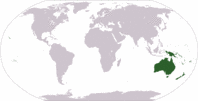Hydriastele boumae
| Hydriastele (high-dree-Ah-STEL-eh) boumae (BOO-meh) | |||||||
|---|---|---|---|---|---|---|---|
 "An underside look." On Taveuni Island, Fiji. Photo by Jim Valentine. | |||||||
| Scientific Classification | |||||||
| |||||||
| Synonyms | |||||||
|
| |||||||
| Native Continent | |||||||
|
| |||||||
| Morphology | |||||||
| |||||||
| Culture | |||||||
|
| |||||||
| Survivability index | |||||||
|
| |||||||
| Common names | |||||||
|
| |||||||
Contents
Habitat and Distribution
Restricted to the island of Taveuni, Fiji. Currently known with certainty only from the Bouma area, but unconfirmed reports suggest it also occurs in the Soqulu area. Undisturbed forest and mature secondary forest between 50 and 800 m. elevation. (R. Phillips, pers. comm.). (W.J. Baker and A.H.B. Loo. 2004)
Description
Robust, solitary palm to 32 m. Stem 26 - 28 cm in diam., brown, nodal scars inconspicuous, adventitious root growth forming an expanded cone at base of stem about 15 cm in height. Leaf to 2.4 m long including petiole, to about 3 m in juveniles; sheath 90 cm long, forming distinct crownshaft, green, with thin, caducous, powdery indumentum of fine, white scales, interspersed with white, filamentous scales and scattered, dark brown scales; petiole 33 - 35 cm (to 1.2 m in juveniles), 60 x 14 mm at base, channelled adaxially, rounded abaxially, indumentum as sheath; rachis about 2 m, arcuate, strongly so in canopy-emergent individuals, indumentum as sheath; leaflets 52 - 57 on each side of rachis, briefly praemorse and sometimes notched at apices, adaxial surface dull green, abaxial surface silvery grey-green, mid-rib yellow, arranged regularly, ascending, not drooping at tips, lamina entire or nearly so in non-emergent individuals up to 12 m or more in height, longest leaflet at middle of rachis to about 97 x 3.5 cm, apical leaflets about 13 x 0.6 cm, ramenta not observed. Inflorescence infrafoliar, about 70 cm long at anthesis including about 10 cm peduncle, branched to 2 (possibly 3?) orders, protogynous; prophyll not seen, caducous; peduncular bracts about 3, first peduncular bract caducous, not seen, but most likely closely resembling prophyll, remaining peduncular bracts and rachis bracts consisting of low membranous flanges, to 16 x 2 mm, sometimes bearing an acutely apiculate extension; primary branches about 17, to about 50 cm long, closely spaced, inserted at a narrowly acute angle to the rachis; rachillae to about 45 x 0.4 cm, somewhat arching; rachilla bracts very inconspicuous; triads 2 - 5 mm apart, decussate. Staminate flowers 10 - 11 x 3.5 - 4.5 mm shortly before anthesis, asymmetrical, white; calyx with 3 triangular, imbricate sepals about 1 x 1.5 mm; corolla with 3 narrowly triangular to lanceolate, valvate petals 8 - 10 x 3 - 3.5 mm, outer surface spotted at base; stamens 6, filaments 0.6 - 1 x 0.5 - 0.6 mm, anthers 5 - 5.8 x 1 - 1.2 mm; pistillode minute, trifid. Pistillate flowers about 4 x 3 mm at anthesis, cream white; perianth forming low, leathery cupule, calyx with 3 rounded, imbricate sepals about 2 x 3 - 3.5 mm; corolla with 3 rounded, imbricate petals to 1.5 - 1.8 x 2.5 - 3 mm; staminodes 1 - 3, minute; ovary 2.5 x 2.5 mm, globose, protruding from perianth cupule at anthesis, style absent, stigmas minutely trifid. Fruit oblong, 10 - 14 x 6- 8 mm, pericarp about 0.5 mm thick, epicarp yellowish white when ripe, with persistent perianth forming a narrow cylinder at base, 3 - 3.5 mm in diam. Seed about 9 x 6 mm, oblong; endosperm homogeneous; embryo basal. (W.J. Baker and A.H.B. Loo. 2004) Editing by edric.
The existence of an undescribed species of Hydriastele from the island of Taveuni in Fiji has been suspected for some time (Fuller 1997). Recent collections have allowed us to compare this palm with other species in the region. It most closely resembles H. cylindrocarpa and H. vitiensis, but is readily distinguished from both. The new taxon is separated from the other Fijian species, H. vitiensis, by its rachillae with decussate triads as opposed to triads arranged in alternating whorls of three, by fruit morphology (10 - 14 x 6 - 8 mm and symmetric oblong in the former, aBOUT 10 x 3 mm and slightly curved cylindrical in the latter), and, most strikingly, by its leaves remaining subentire to entire until the crown emerges from the forest canopy. Individuals over 12 m in height have been observed bearing scarcely divided leaves. The leaves of H. cylindrocarpa from Vanuatu behave in a similar way, but the fruit of this species differs from that of the new taxon in bearing an open cupule of enlarged, persistent perianth, while the persistent perianth of the new taxon is not enlarged and forms a small, narrow cylinder at the base of the fruit. The new species, H. boumae, is named after Bouma, the district of Taveuni in which it grows. (W.J. Baker and A.H.B. Loo. 2004)
Culture
Cold Hardiness Zone: 10b. New to cultivation with seedlings requiring tropical/warm sub-tropical conditions, some filtered light and protection from strong winds.
Comments and Curiosities
- IMAGE GALLERY
External Links
References
Phonetic spelling of Latin names by edric.
Special thanks to Geoff Stein, (Palmbob) for his hundreds of photos.
Special thanks to Palmweb.org, Dr. John Dransfield, Dr. Bill Baker & team, for their volumes of information and photos.
Glossary of Palm Terms; Based on the glossary in Dransfield, J., N.W. Uhl, C.B. Asmussen-Lange, W.J. Baker, M.M. Harley & C.E. Lewis. 2008. Genera Palmarum - Evolution and Classification of the Palms. Royal Botanic Gardens, Kew. All images copyright of the artists and photographers (see images for credits).
Many Special Thanks to Ed Vaile for his long hours of tireless editing and numerous contributions.














